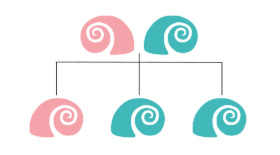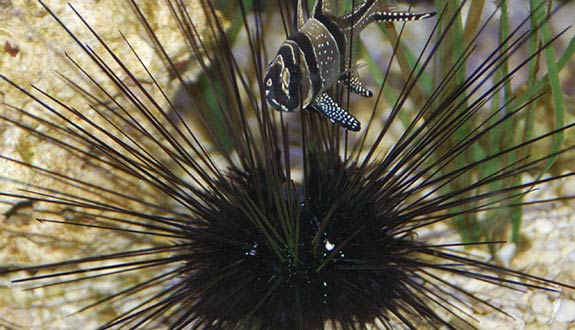

Alternative species (click on the thumbnail to see the card)
Names
Scientific name
Diadema setosum
Common name
Long-spined sea urchin
Long-spine urchin
Diadem urchin
Porcupine sea urchi
Needle-spined urchin
Origin

Origin: Indian Ocean, South Pacific and Mediterranean Sea (25m/27yard depth)
Natural habitat: on the sand in the lagoons of coral reefs (sometimes in seagrass beds and damaged environments)
Dimorphism

None
Group

Diadematidae
Volume

300 L / 66 imp gal / 79 US gal
Parameters

T°: 22 à 28°C or 72 to 82°F
pH: 7.5 to 8.5
Density: 1021 to 1024
Difficulty

Average
Size

9cm (3.5") / with quills: 40cm (16")
Longevity

3 to 5 years
Living zone

Middle and depth
Individuals

1
Food
How to feed the urchin?
Food
How to feed the urchin?
This sea urchin is herbivorous. It will find food in your aquarium: it has five powerful teeth used to scrape the algae decor and substrate. It participates in the non-proliferation of algae in your aquarium.
To complete this «natural» diet, offer broccoli or boiled spinach.
Behavior
What kind of behavior does the Palette urchin have?
Behavior
What kind of behavior does the urchin have?
The Diadem urchin is a sociable animal. It is especially active at night with its favorite activity: thoroughly clean your decor! Let’s not kid ourselves, it’s all about filling its belly... During the day, it’ll rest sheltered under rocks or corals. Sometimes, the Diadem urchin can also gather on the substrate (it is a defense technique in its natural environment).
Cohabitation
Who can live with the urchin?
Cohabitation
Who can live with the urchin?
It enjoys the company of its peers, which is why it is better to keep it in groups of 3 or 4 specimens. However, in order to have such a group, it will increase the volume of the proposed aquarium because in a tank of 300 liters or 66 Imp Gal or 79 US Gal, it is recommended to introduce only one sea urchin.
Never associate them with titan triggerfish and Tetraodontidae which are their natural predators. Outside this family, cohabitation with fish is very easy (the two parties are simply ignored).

It has a symbiotic relationship with the family Apogonidae (such as Pterapogon Kauderni for example) and Diademichthys lineatus. This type of association is highly recommended.
Finally, cohabitation with other invertebrates is not a problem.
Breeding
How to breed the urchin?
Breeding
How to breed the urchin?
The breeding of the Diadem urchin is quite common, when the temperature exceeds 24°C or 75°F.
To do this, male and female loose their breeding cells (gametes) directly in the water and simultaneously. Fertilization is external. The larvae are tiny and will undergo various transformations before forming small sea urchins.
Its aquarium
Which aquarium for the urchin?
Its aquarium
Which aquarium for the urchin?
This invertebrate will easily find its place in a reef aquarium. A decor composed of rocks, anemones and corals will suit him very well. It does not degrade its habitat, except in aquariums too small where its browsing activity can damage the corals in the long run, or on the younger corals.
Consider this species in at least a tank of 300 liters or 66 Imp Gal or 79 US Gal, rich in living stones and corals.
Good To know
Find all additional information!
Good To know
Find all additional information!
The Diadem urchin is particularly sensitive to sudden changes in density. In some cases, it can make it loose its quills.
It moves with ambulacral feet with a suction cup. If necessary, its shorter ventral spines can also be used as stilts to go faster and flee in the face of danger, for example.
There are actually 3 species of Diadem urchin.
Be careful when transferring, it is better to avoid that it is in contact with the air. Indeed, it may be difficult to expel the air it will absorb, even for a short time.
The round envelope that protects it is called «test». This word comes from the Latin «testa» which means «shell, carapace». Its quills are a great way to protect itself. Yet they are thin and brittle. You will observe that at rest, the sea urchin unfolds them widely. In case of aggression, it will instead straighten them in the direction of its opponent and agitate quickly to intimidate. When a sea urchin touches its opponent, its thorns break in its flesh which accentuates the pain. In addition, it secretes a toxin that causes severe burning. These effects can vary from one individual to another, from simple burning to nausea, paralysis or even cardiac arrest. If you have been bitten, monitor the area and do not hesitate to consult a doctor.
It can be confused with the following species:
> Diadema savignyi, of which it is very close. Unlike D.Setosum, it does not have an orange circle around the anus, its quills are a little shorter and have blue highlights.
> Echinothrix diadema. This species has a very black color. Its test is wider than D.Setosum and its quills are shorter.
> Astropyga radiata, easily recognizable by its wide red test. Its spines are also shorter.
> Echinothrix calamaris, smaller. Its prickles are white ringed with black.
Note that D.Setosum and D.Savignyi can hybridize.
Yours photos!
Comments
Sort by:
Please login to post comments

